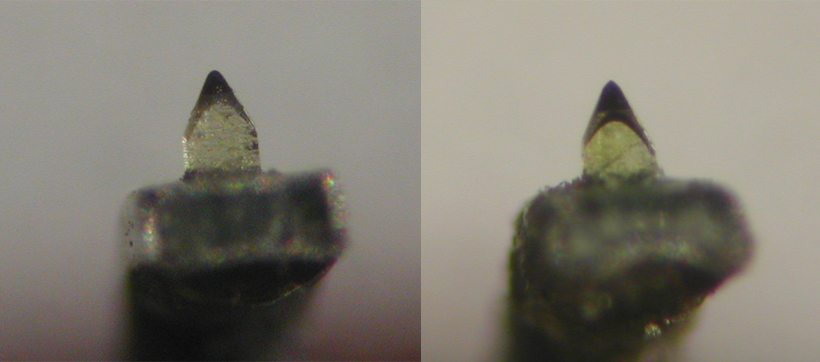I’ve been working closely with records and cartridges for 40 years and am in particular debt to the expertise and knowledge of Dynavector Systems, Tokyo, the brand that my company, Pear Audio, distributes in the UK. There are two things in the design of most moving coil phono cartridges that determine their useful lifetime. Wear on the stylus tip and condition of the suspension damper rubber.
Stylus wear
The stylus tip can wear down such that the point eventually grounds in shallow grooves creating bad distortion. This is often due to poor care of both records and stylus and can be avoided. At Pear Audio we recommend cleaning records with a carbon fibre brush immediately before playing. Especially second hand or dusty records but also new records. There are often small pieces of metal swarf from the stamper on records that can be attracted to the magnets of a cartridge.

The stylus ought to be kept clean. Dynavector supply a short haired brush that used in conjunction with stylus fluid will do this. Note that it is important that the fluid does not contain alcohol or other harsh chemicals. These could loosen the cement bonding the stylus to the cantilever. Other methods include using a moistened cotton bud to dab at the stylus (carefully!) or very fine abrasive paper (30 micron), being very careful to not apply too much force. A compressed air blower is useful for blowing large bits of dust off. But be careful not to direct the jet inside the mechanism as this might dislodge coil wiring.
There are a number of stylus cleaning fluids on the market and at Pear Audio we make one up and can supply suitable brushes for applying it. It is also invaluable to have a microscope to check the condition of the stylus as the images on this page reveal. The difference between a worn stylus and a new one doesn’t look very significant even at this level of magnification but because the signal cut into a vinyl groove is so small you can hear a much clearer difference than can be seen.

Damper rubber deterioration
The damper rubber is part of the stylus cantilever and coils assembly. It damps the tie wire/s that hold the whole assembly taught and prevent ringing. The rubber degrades over time naturally and eventually dries out thus reducing the damping effect. The initial phase of this process usually manifests itself in the sound becoming thick and muddy. This gives way to high frequency distortion akin to mistracking. The final stage is very obvious but the downhill run is less so unless a comparison is made to a new cartridge. One gets used to the gradual change in sound. And deterioration occurs whether the cartridge is used or not. So play on.
The biggest external factor is contamination of the damper caused by dirt from records or fluid getting in whilst cleaning the stylus. Which is a good reason to use stylus fluid sparingly and choosing one that does not contain harsh chemicals. Distilled water works well if nothing else is available.

New (left) and worn (right) stylii
So, how long do cartridges last? If records and the stylus are kept clean then it will be the damper rubber that determines life. We know of some customers who have obtained seven or eight years use from well looked after cartridges. This applies to most makes and models of cartridge too. This does not mean they will not be safely playable after that time but they will be past their prime as a comparison to a new one should demonstrate. If the cartridge is heavily used then the stylus wear may become a factor. Any obvious distortion should always be checked out immediately and the cartridge should ideally be checked by your dealer annually but it is unlikely any record damage will occur unless obvious distortion is heard.
Tip replacement
If you have read this far it should be obvious that having a new stylus spliced onto the cantilever of an old cartridge will not restore the sound even if whoever does it manages to repeat the original manufacturing quality. It’s a bit like putting Pirelli P Zero tyres on an old car with worn out suspension. Equally if a ‘full rebuild’ is performed by third parties it is unlikely to be done using original components thus the performance cannot match the original. The cartridge is the part of the Hi Fi chain we would be most reluctant to buy second hand unless a genuine history was available and a sound warranty.

The relative size of a cocktail stick and Dynavector 10X5 cantilever and stylus at 80x magnification
‘Matching’ cartridges to phono stages
Every phono stage has different characteristics and it is the stability of the circuit that is established when setting ‘loading’ rather than ‘matching’ cartridge to the input. The only way to find the optimal setting for a phono stage is to listen to it at its various settings and pick the best sounding, if indeed you hear any difference. You will then find that no matter which cartridge you use with it will most likely work best at that setting.
The best way to listen is over a period of time so everything gets a chance to stabilise and warm up properly. Bear in mind that new components will change in their first 50 hours or so as capacitors and mechanical components ‘run in’. This goes for the cartridge too. We have seen trackability improve measurably on a cartridge which has been run about 30 hours. Make sure not to go below the cartridge manufacturers minimum recommended load and use the gain setting to bring the phono stage output as close to other sources as possible.
John Burns


